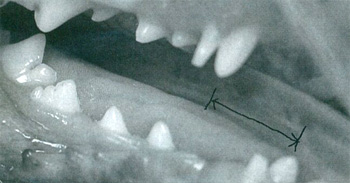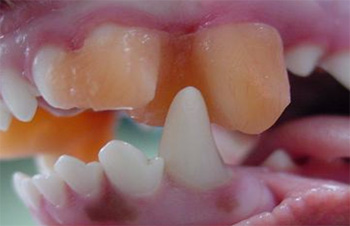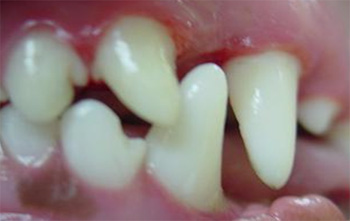|
By David E. Hansen, DVM, FAVD, DAVDC
Fellow of the academy of Veterinary Dentistry
Diplomate of the American Veterinary Dental College
Malocclusions
There are five basic classes of occlusion. The first is Class O - normal, which includes true normals and variations of normal (breed specific). See "Normal Occlusions" in Part 1. The second is Class I malocclusion, in which the teeth are in approximately normal anterior/posterior relationship, but are out of position in a facial or lingual direction. These would include anterior crossbite, posterior crossbite, base wide canines, base narrow canines, crowded or rotated teeth and some partial level bites. The third is Class II malocclusion (brachygnathism) in which some or all mandibular teeth are distal or posterior in relationship to their maxillary counterparts (Figure 1). This is either due to a short mandible or long maxilla.

Figure 1: Class II malocclusion
The fourth is Class III malocclusion (prognathism) in which some or all of the mandibular teeth are mesial or anterior and in their relationship to their maxillary counterparts (Figure 2). This is either due to a long mandible or a short maxilla.

Figure 2: Class III malocclusion
The fifth is Class IV special malocclusions, which is a specific form of “wry” mouth in which one of the mandibles is in a mesial relationship while the other is in a distal relationship (Figure 3).

Figure 3: Class IV malocclusion – “Wry Mouth”
Occlusion Development
There are a series of events that must occur in proper sequence or long-term complications will occur. Basic growth patterns in the oral cavity can help you know when to intervene to prevent further developmental defects. There has been much speculation as to the inheritability of occlusal patterns, but very few facts are known.
The developmental defects can be divided into three major staging periods. Each stage has its own set of problems. Stage 1 is from zero to sixteen weeks of age, Stage 2 is from sixteen weeks to seven months of age and Stage 3 is from seven months to one and one half years of age.
Stage 1:
Dogs are born with “overshot” maxilla’s allowing the newborn to nurse. As the puppy grows and the transition from mother’s milk to solid food occurs, the mandible goes through a growth spurt nearly catching up to its relative adult percentage of jaw length. If this growth spurt does not occur and the deciduous teeth erupt, the mandibular canines will most likely be behind the maxillary canines (Figure 4).

Figure 4: Severe Class II – deciduous lower canine behind the
maxillary canine.
This creates a malocclusion with a potential for inhibiting or interfering with any chance for the mandible to catch and seek its proper length. If this is noticed in a puppy (preferably at 8 weeks), the best therapy is to extract the mandibular deciduous canine teeth and incisors (very carefully so as not to damage the permanent tooth buds) (Figure 5). The mandible will have the opportunity to grow to its genetic potential. If the puppy is genetically predetermined to have a significant overbite this treatment will not affect the outcome.

Figure 5: The mandibular deciduous canine and incisors
were extracted.
The other defect to watch for is an “under bite”. This occurs when the mandible grows ahead of schedule and becomes too long for the maxilla. It is usually evident as early as eight weeks of age. The deciduous maxillary incisors occlude inside the mandibular incisors in the mandibular canines are up to or even in front of the lateral incisors (3rd). Normally the treatment is to carefully extract the maxillary central and middle incisors (1st and 2nd) leaving the lateral incisors if they are acting as a deterrent to the growth of the mandible. The prognosis for the adult dentition to be normal is not as favorable, however early intervention is the best hope.
Other problems that require intervention include extra teeth or gross displacement of a deciduous tooth. Asymmetry of the maxilla and/or mandible (wry) is dealt with by extracting the teeth on the under-developed side. These usually carry a poor prognosis for correction, but will give the puppy every opportunity for “self-correction”.
Stage 2:
The hallmark of problems in this stage is the retention of deciduous teeth. The normal shedding process begins around 12 to 14 weeks of age with the loss of the maxillary central incisors. For the following three months the deciduous teeth are replaced with permanent teeth plus additional permanent teeth to complete the dog’s dentition. If the deciduous teeth are not lost at the time of eruption of the counterpart permanent tooth a malocclusion occurs. No two teeth can occupy the same place at the same time, so the permanent tooth is always in malocclusion. The treatment of choice is to extract the deciduous tooth as soon as retention becomes evident.
Other developmental defects that occur in this stage include base narrow canine teeth, mesial tipping of the maxillary canines and Class II malocclusions. When the canine teeth are erupting, a window of opportunity exists for simple orthodontic correction of base narrow displacement of the mandibular canine teeth with an acrylic maxillary incline plane (Figure 6a) (Figure 6b – 6 weeks later).

Figure 6a: Acrylic maxillary incline plane.

Figure 6b: 6 weeks later.
Using the correct size hard rubber ball as the sole toy has corrected some of these. The ball must allow the tips of the canine teeth to contact it at a 45 degree angle. The longer the dog carries the ball around the better the results. (Figure 7)

Figure 7: A “removable” orthodontic appliance.
The mesial tipped maxillary canine tooth, which is most common in Sheltie breed, can be tipped back using buttons and an elastic chain (Figures 8 and 9).

Figure 8: Buttons and an elastic chain to move a mesially
tipped upper canine.

Figure 9: The buttons and elastic chain can be removed
after 8 weeks.
For more severe Class II malocclusions where the mandibular canine teeth are occluding on the palatal surface of the maxillary canine teeth, options such as crown reductions of the mandibular canines or extractions should be considered to prevent palatal trauma and pain. (Figure 10)

Figure 10: Lower canine after crown reduction, endodontic
treatment and restoration.
Stage 3:
The final stage of developmental occlusal defects occur from 7 months to 18 months of age. Anterior crossbites, posterior crossbites, crowding, rotated teeth along with the final expressions of prognathism and brachygnathism become evident. Anterior crossbite can be dealt with if the remaining dentition is within normal limits (however most anterior crossbites are a result of a Class III malocclusion) (Figures 11, 12, 13,14).

Figure 11: Class I malocclusion – anterior crossbite.

Figure 12: Expansion device to move maxillary middle incisors.

Figure 13: Expansion device on upper teeth, Restrictive
device on lower teeth.

Figure 14: Orthodontic appliance removed – scissors bite.
Some posterior crossbites are dealt with by extracting the maxillary fourth premolar. This can prevent periodontal disease from developing and if the lower molar is contacting the maxillary fourth premolar creating an open bite, allows the mouth to close all the way. If the bite is functional, no treatment is needed. The crowding of teeth can be resolved by extracting some of the crowded teeth. (Figure 15)

Figure 15: Posterior crossbite.
In conclusion, there is still not very much known about the inheritability of developmental abnormalities. There are many outside factors that also play a role in the final outcome. It is thought that Class II and III malocclusions, which have to do with the mandible and maxilla relationship are more likely to have genetic factors. The Class I malocclusions which affect individual teeth only can have more outside influence, but still can have some genetic factors. Those dogs that have malocclusions are more likely to produce offspring that have the same problem, however normal occlusion parents can still produce malocclusions and some seem to skip generations.
Related Articles
> Oral health issues in the dog: Developmental abnormalities
of the teeth and oral cavity
> oral health issues in the dog: Normal anatomy of the teeth and oral cavity
|